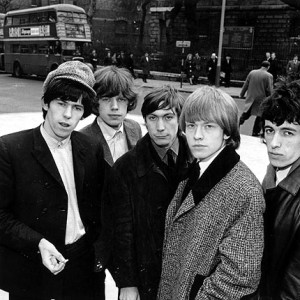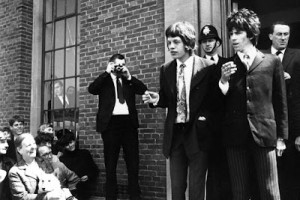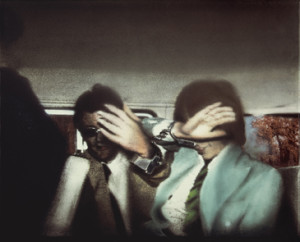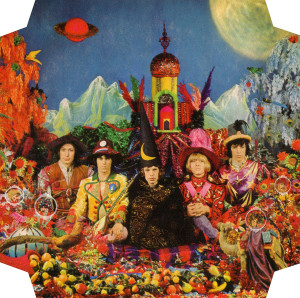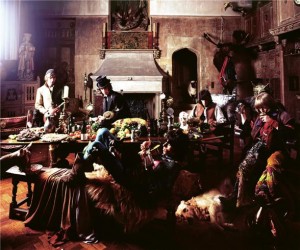Continuing with the 50th anniversary of the Rolling Stones, GIITTV charts the key episodes, misdemeanours and records that shaped one of the world’s greatest Rock and Roll bands.
Part 2 covers the drug trials of 1967 to the barricade breaching protest anthem of Street Fighting Man.
11.Wired
It would of course be a dereliction of duty on your humble authors part to not mention the Rolling Stones predilection for drugs, or as it’s fondly termed by both the press and the band, their use is purely ‘recreational’. In 1967 a so-called News of the World exposé – ‘Pop Stars and Drugs: Facts That Will Shock You’ – turned the spotlight on the LSD parties of the London music set; naming and shaming such luminaries as The Moody Blues, Pete Townshend, Ginger Baker, Donavon and of course, the Stones or rather Jagger, Richards and Jones. The Mellow Yellow man himself was raided soon after the article before the rozzers set the sights on the Stones.
This would become the catalyst for the drug merry-go-round that’s now become both legendary and a myth as the drugs got heavier and the free-loving swap-around of partners took its toll. What started out as fun and experimental soon turned sour, as certain band members developed into junkies. The harshest ravages of a dependency could be seen clearly on Jones.
The charge sheet of misdemeanors includes:
Jagger wrongly fingered by idiot reporter at the Blaise Club, London –
Apparently spotted downing some Benzedrine before producing a lump of hashish from his pocket and inviting everyone back to get loaded. Turns out it was in fact a case of mistaken identity: right band, wrong member; it was in fact Brian Jones not Jagger (who filed a writ for libel against the paper).
Redlands party turns sour, as Keith Richards quaint cottage on the Sussex coast is raided a week later –
Literally a stones throw away from where your author is writing this very piece, Richards charming West Witterings country pile, just south of Chichester, was a getaway bolt hole from London. A place where, he believed wrongly, that they could continue those drug fest gatherings without interference. A tip-off to the goings on at Redlands from the NOW (who claimed it was Richards chauffer who gave them the nod) soon put paid to that little shindig. Infamy reigns over this particular gathering on February 12th 1967 for the Marianne Faithfull angle. Bedecked in a rug and nothing else, surrounded by Robert Fraser (who evidently tried to pass off his heroin as diabetes pills), Jagger (graciously came to Faithfull’s distress by claiming that the Benzedrine pills she was found with were his) and Richards.
No case of mistaken identity this time as Brian Jones is raided –
At the same time as the Redlands debacle, Jones had his collar felt, becoming the third Stone to be put up on charges alongside their art-dealer friend, Robert Fraser.
12. Trials and tribulations abound as the three Stones face the beak/ Release.
The Rolling Stones would now face the wrath of the courts for the Redlands party, as they were set-up by the establishment to receive a drastic judgment, and condemnation on their lifestyle choices.
The first trail involved Jagger who was given a three-month prison sentence for possession of four amphetamine tablets.
Next up before the bench was Richards who was found guilty of allowing cannabis to be smoked on his property and was handed a one-year sentence in prison. Meanwhile Fraser received a six-month sentence.
Both shockingly heavy-handed, even for the times, Richards and Jagger’s walked free on the condition of a pending appeal. Condemnation at the harsh terms came from the music and art world, with the now famous William Rees-Mogg Times article, ‘Who Breaks A Butterfly On A Wheel?’, adding a poetic sign of solidarity to the Richards/Jagger cause. Eventually they were both acquitted, though Fraser was not.
Jones’ trail was set later that year and he was given a £1000 fine plus three-year probation. The judge also ordered the bowl-cut cherub to seek professional help.
Captured by the guiding light of British pop art, Richard Hamilton, in his iconic Release painting, Fraser and Jagger’s handcuffed ride to court is immortalized forever as a synonymous window on not just the trail of the 60s but as a leading image from that epoch.
Fraser the Etonian, Mayfair art-dealer tastemaker, and Jagger the enfant-terrible front man of the wild Stones marks the start of a cultural and class breakdown. Without a doubt he craved the attention of the stars, picking from a discerning set, but he nevertheless was a crucial cog, not only in introducing the pop set to the art world (it was Frasser who turned The Beatles onto Peter Blake for their Sgt.Pepper album cover and persuaded them to let Hamilton design The White Album), but also for his eccentricity and social poise.
13. We Love You
As a grand gesture of appreciation to the fans and friends who supported the Stones during their trails, Jagger/Richards penned this Kasbah psychedelic halcyon Mellotron thanks.
Tape-delay, various Foley jail sounds, Nicky Hopkins thundering piano echoes and a chorus of musical compatriots (including Lennon and McCartney) led by a Shiva bead-wearing Allen Ginsberg, combine to produce a real tripped-out two-fingers to the establishment. Of course, Lennon considered the song a veiled pastiche of All You Need Is Love; dismissing it as “fuckin’ bullshit” in a 1970 Rolling Stone article.
An accompanying video directed by counterculture documenter, Peter Whitehead, plays out the trial of Oscar Wilde.
14. Their Satanic Majesty’s Request
Despite the upheaval and tribulations of the various court appearances and persistent media hounding, the stones managed to produce their sixth studio album, Their Satanic Majesty’s Request.
Sporadically coupled together from scarps of ideas to experimental indulgences and without a guiding producer on hand, this psychedelic mess still boasted some gems. Bill Wyman, weary of the drugs, had in effect found himself one of the only band members able to function, as his cohorts wandered in-and-out of recordings on a whim. Richards, Jagger and Jones would often bring an entourage each of various famous faces, groupies and hangers-on, holding court all the while and contributing when it pleased them. Both Wyman and their manager, Andrew ‘Loog’ Oldham, were frequently disillusioned with the carefree extravagance; Oldham deciding to distance himself completely from both the drug busts and the album, before finally quitting.
The positives include the maelstrom acid-rock maelstrom, Citadel; the vibrant piano love-paean, She’s A Rainbow; and the kosmiche sonic opus, 2000 Light Years From Home. The musical palate is arguably extended well-beyond anything the Stones had immersed themselves in before; including the use of the electric dulcimer, harpsichord, tablas, harp, flute and theremin.
In no ways an equal of Sgt.Pepper, it’s nonetheless a well-attempted experiment to seek new horizons and dabble with inventive prose and melody. Much better record than critics, and even the band themselves, would have you believe.
15. In Another Land
Written and sung by Bill Wyman, In Another Land was a rebuttal against his fellow band member’s languorous state, and persistent drug dazed state. A dream within a dream, the space-y and Wurlitzer misty shrouded lament was initially something Wyman had been toying around with away from the recording sessions. A fatalistic cancellation had opened a window for Wyman, who was encouraged by the Stones engineer on Their Satanic Majesties Request, Glyn Johns, to record anything he might have laying about.
Included on the session were the Small Faces’s Steve Marriott (on 12-string guitar and backing vocals) and Ronnie Lane (backing vocals) alongside Nicky Hopkins and Charlie Watts. Richards and Jagger later added their backing vocals and, as a playful joke, a recording of Wyman snoring – only appears on the LP version.
16. She’s A Rainbow
“She comes in colours everywhere;
She combs her hair
She’s like a rainbow
Coming colours in the air
Oh, everywhere
She comes in colours
Have you seen her dressed in blue
See the sky in front of you
And her face is like a sail
Speck of white so fair and pale
Have you seen the lady fairer
She comes in colours everywhere;
She combs her hair
She’s like a rainbow
Coming colours in the air
Oh, everywhere
She comes in colours
Have you seen her all in gold
Like a queen in days of old
She shoots colours all around
Like a sunset going down
Have you seen the lady fairer
She comes in colours everywhere;
She combs her hair
She’s like a rainbow
Coming colours in the air
Oh, everywhere
She comes in colours”
17. Jumpin Jack Flash
As the shambles of the previous psychedelic, Their Satanic Majesty’s Request, dream turned sour, the Stones in a pique of inspiration went back to their roots. They conjured up a mythical, Voodoo shot of bourbon blues with the strange brew rocker, Jumpin Jack Flash: considered one of the Stones most engaging, influential and popular hits.
Although conceived during, and as an extension, of the heady acid-glazed days of 67, it was in the following year that the band began sessions for their next album, Beggars Banquet, and this delta London via New Orleans swaggering single.
This would also mark the announcement of a new Rolling Stones sound, as Richards began to tune his guitar to the resonating and distinctive open D/E chords; learning a trick or two from stateside blues players.
18. Beggars Banquet
Fed-up with the whole hippie trip and motivated to take a look back at the blues and rock’n’roll roots that the band were suckled on, Beggars Banquet would be a welcome return to form. Like Bob Dylan before them, the Rolling Stones warmed to the lure of an imagined, sepia-tinged old America on the tracks Prodigal Son, Parachute Women and Dear Doctor, but they also turned to commentating on the contemporary social turmoil of the times with Street Fighting Man, Jigsaw Puzzle and Salt Of The Earth.
Possibly their greatest album, Beggars was led by the Stones most controversial and temptress song, Sympathy For The Devil. A narcissist narrative that was inspired by the decades more dark and depressing moments but mentions a catalogue of historical atrocities from Christ’s crucifixion to WWII – evidently the singular John F. Kennedy assassination was changed to incorporate the recent Robert Kennedy murder that took place just as recordings were under way.
19. Rock and Roll Circus
Conceived as a promotional tool and as a means to branch out from the usual publicity campaigns and touring slog, the Rock and Roll Circus was to be a showcase for the recently finished Beggars Banquet.
Two concerts would take place on a circus themed stage, as the groups many musical friends and chums (including Jethro Tull, Taj Mahal, Marianne Faithfull and Lennon with Yoko Ono) would perform in front of television cameras; the Stones would obviously be the main act and all adulation would pour in. However, The Who pissed on the Stones parade with a blistering, shit-kicking performance that left the hosts in a daze.
Shelved for years the project was hushed-up and myths ran abound about why Jagger pulled it until its subsequent release decades later. As it turned out, the group did perform a rather shambling set that fell apart in places and sluggishly wound-itself down to a disheveled mess. Just watch this clip of Sympathy For The Devil; Jones finding it hard just to keep a pair of shakers in time, whilst the group wander in and out of time – the conga player desperately trying to keep on smiling and amend the gapping holes in the rhythm. Wild man, wild.
20. Street Fighting Man
Another classic cut from Beggars Banquet, Street Fighting Man the soundtrack, of sort,s to the May 1968 protests in Paris, though it’s mantra stance alludes to a whole series of social unrest happening in the world during that year.
Like the Beatles Revolution, the Stones rhetoric cleverly suggested comradeship but at the same time stood aloof and distanced from those who wished to breach the barricades by any means necessary. In a way the almost cynical, ‘it won’t make a difference’ underlining message has proven to be correct


